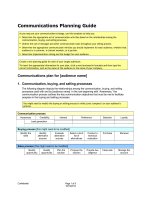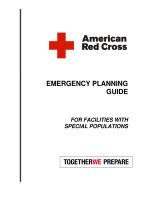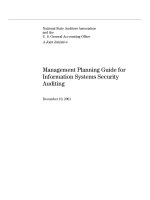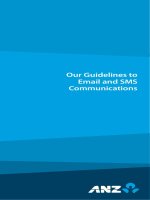Communications Planning Guide
Bạn đang xem bản rút gọn của tài liệu. Xem và tải ngay bản đầy đủ của tài liệu tại đây (118.94 KB, 5 trang )
Communications Planning Guide
As you map out your communications strategy, use this template to help you:
Determine the appropriate set of communication activities based on the relationships among the
communication, buying, and selling processes.
Outline the use of messages and other communication tools throughout your selling process.
Determine the appropriate communication vehicles you should implement for each audience, whether that
audience is a customer, a channel member, or a partner.
Determine implementation timing and the budget for each audience.
Create a new planning guide for each of your target audiences.
To insert the appropriate information for your plan, click a word enclosed in brackets and then type the
correct information, such as the name of the audience or the name of your company.
Communications plan for [audience name]
1. Communication, buying, and selling processes
The following diagram depicts the relationships among the communication, buying, and selling
processes used with and by [audience name]. In the row beginning with “Awareness,” the
communication process outlines the key communication objectives that must be met to facilitate
progress in the buying and selling processes.
You might need to modify the buying or selling process to reflect your company’s or your audience’s
process.
Communication process
Awareness Credibility Interest Preference Selection Loyalty
Lead generation
Buying process [this might need to be modified]
Identify the
need
Identify
alternative
sources
Evaluate
alternative
sources
Select a short
list of
alternatives
Conduct a
technical
evaluation
Purchase Renewal
Sales process [this might need to be modified]
Identify
opportunity
Qualify
opportunity
Plan the
solution
Propose the
solution
Provide due
diligence
Close sale Manage the
account
Confidential Page 1 of 5
10/15/2013
2. Communication process and the evolution of messaging
As your company moves through the communication process, you must evolve your messages to map to
the information requirements of your audience. In general, as you move through the communication
process, your messages should provide more detail and substantiation about your business and products.
Understanding the messages that are required to support the later stages of the buying and selling
processes makes it possible for you to create better messages in the earlier stages of the process. The
following table summarizes how and when you can evolve the essence, or the net “takeaway,” from your
messages.
Communication process—net takeaway from [your company name] messages
Awareness Credibility Interest Preference Selection Loyalty
Lead generation
[your company] is in the [business
type] business.
[your company]’s business
is validated by the industry
and your customers.
[your company] has a vision
for and commitment to the
[business type] business.
[your company] has specific offerings and
capabilities that meet customers’ specific
needs.
[your company] has
strong capabilities that
make it competitive in the
[business type] business.
You made the
right choice in
selecting [your
company].
[your company]d
elivered on its
promise.
[Audience 1] buying process
Identify the
need
Identify
alternative
sources
Evaluate
alternative
sources
Select a short
list of
alternatives
Conduct a
technical
evaluation
Purchase Renewal
Communications Planning Guide Page 2 of 5
10/15/2013
[Your company's] sales process
Identify
opportunity
Qualify
opportunity
Plan the
solution
Propose the
solution
Provide due
diligence
Close sale Manage the
account
3. Communication vehicle options
The types of communication vehicles that you use to support different stages of the buying and selling
processes are dictated by the corresponding communication objectives. In the row beginning with
“Awareness,” the following table outlines the key communication vehicles that support each
communication objective. Not all communication vehicles are required for you to relay your message to
the market effectively. Use the Target Audience Profiling Questionnaire to understand fully how your
audience finds information and to select the most appropriate communication vehicles based on your
audience’s preferred sources for information.
In conjunction with the preceding table, which outlines the evolution of messaging throughout the
communication process, marketing communications specialists can use the following table to determine
how best to focus messages in each communication vehicle.
Communication process—sample communication vehicles
Awareness Credibility Interest Preference Selection Loyalty
Press briefing or
tour, or both
Press mentions Business white
papers
Data sheets and
other detailed
product collateral
Proposal
templates,
invoices, and
other company
documents
“Thank you” and
“just checking in”
communications
by e-mail, regular
mail, phone, or
other modes
Press releases
and associated
materials
Analyst quotes,
references, and
mentions
Press articles Feature and
functionality
presentations,
videos, and
other types of
demonstrations
Customer
references
Internet
marketing
Analyst briefing
or tour, or both
Customer and
partner quotes
and references
Analyst papers
and
presentations
Printed customer
success stories
E-commerce
Web site
Company
informational
Web site
Company or
product overview
collateral
Conference
speaker
presentations
Capabilities
brochure
Industry event
trade show floor
participation
Company or
product overview
slide
presentation
Competitive
positioning
advertising
Return on
investment (ROI)
tools
Awareness
advertising
Product
overview
demonstration
on Web
Direct marketing Technical white
papers
Communications Planning Guide Page 3 of 5
10/15/2013
Public relations Press and
analyst article
reprints
Internet
marketing
Direct-response
advertising
Internet
marketing
Direct marketing
4. Communication vehicles selection for [audience]
Use the Target Audience Profiling Questionnaire to get a detailed breakdown of your audience’s
demographics and psychographics. This will help you understand how your audience finds information,
and it will help you select the most appropriate communication vehicles based on your audience’s
preferred sources for information.
In the following table, for each communication objective listed in the row starting with “Awareness,” list
the communication vehicles that are most appropriate for your audience. By assigning vehicles to
communication objectives, you get a sense of the timing and order in which you should implement your
communication vehicles.
Communication process—communication vehicles for [audience]
Awareness Credibility Interest Preference Selection Loyalty
Communications Planning Guide Page 4 of 5
10/15/2013
5. Communication vehicles tactical calendar for [audience]
In the following table, list all your communication vehicles in the first column. Add rows if necessary.
Change the month headings to correspond to actual month names. Place an “X” in the column for the
month in which you want the communication vehicle to be delivered to your audience. In most cases, the
delivery month will be different from the production month, which you’ll need for step 6.
Communications vehicle tactical calendar for [audience]
Vehicle [Month 1] [Month 2] [Month 3] [Month 4] [Month 5]
6. Communication vehicles budget for [audience]
In the following table, list all your communication vehicles in the first column. Add rows if necessary.
Change the month headings to correspond to actual month names. Place the cost of each vehicle in the
month during which you expect to pay the expenses for production of that vehicle. Total each column to
determine your monthly budget. Note that for some vehicles, production will take more than one month,
and in many cases installment payments will be required over a series of months.
Communications vehicle budget for [audience]
Vehicle [Month 1] [Month 2] [Month 3] [Month 4] [Month 5]
$ $ $ $ $
Total $ $ $ $ $ $
Repeat the preceding six steps for each additional audience.
Communications Planning Guide Page 5 of 5
10/15/2013









